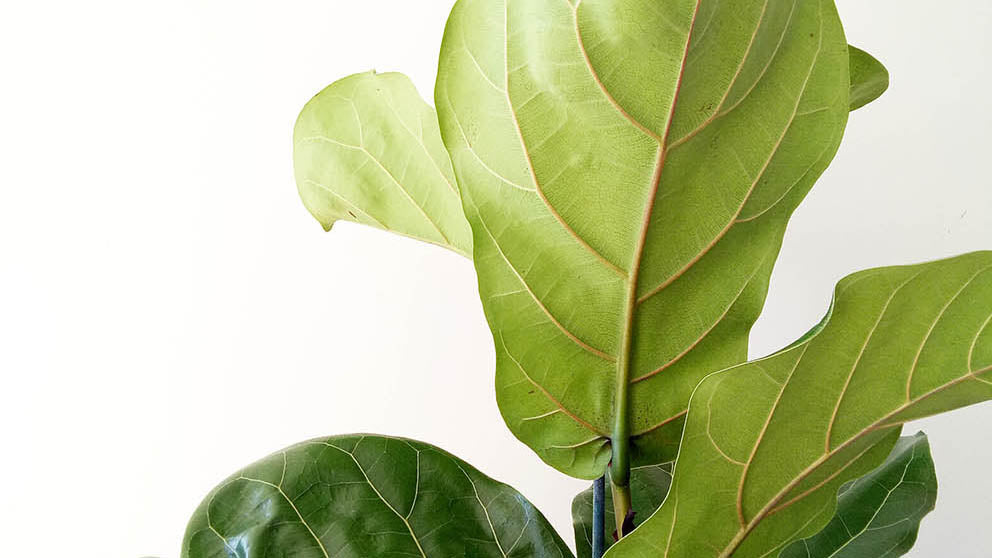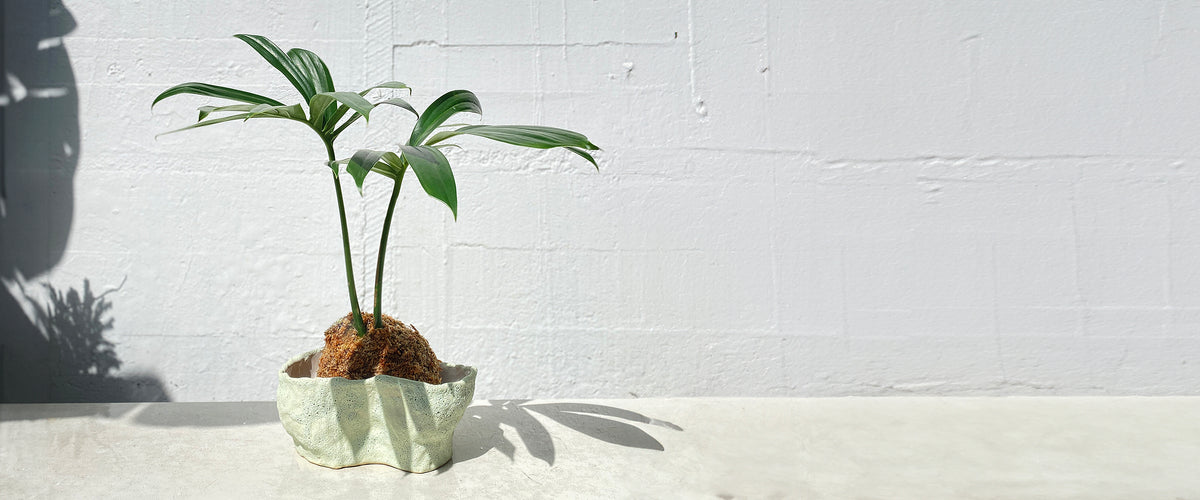Fiddle-y Fiddle Leaf Figs

The fiddle leaf. Also known as a Fig Banyan tree or Ficus Lyrata, it's been growing for millions of years along the West African coast. It's also been the cats pyjamas for plant collectors since 2010 when Pinterest first launched, giving inspiration to avid home designers everywhere. She hasn't gone anywhere either! Fiddle leaf figs are still one of the "it" plants, and for good reason. They're beautiful! An artfully spindly trunk, with large, glossy green leaves that bring any dead corner to life.
But, unfortunately the good must come with the bad. Fiddle leaf figs (or FLF's as known in the plant community) are notoriously fussy plants. Sometimes you may feel like you could look at it wrong and a leaf will fall dramatically to the floor.
Crispy edges, falling leaves, and spotty new growth are among the common snags you may come across after purchasing your FLF, but never fear! There's (almost) always a solution!
We'll start with the best way to prevent any of these problems- proper care.
The key to understanding the best care for any plant is to know it's origins. A plant like the Ficus Lyrata is from West Africa, naturally growing in a hot and humid environment. The FLF is actually an epiphytic plant, starting it's life on top of an established tree and eventually taking it over. To flourish as she does in the wild, she needs high humidity and heat, bright light, and well draining soil to combat her thirsty disposition and epiphytic tendencies.
Light
Ficus looooove a bright space, the more the better. Don't stick her in blazing direct light though. The secret is indirect light. Think a bright room, in the spaces where the sunlight isn't hitting directly. It's a bit hard to explain, but once you see it, you'll know it. If you can't avoid the direct sun though, morning sunlight is always better than harsher afternoon light. If you've got your FLF in a dark corner, chances are things will go sideways- literally. She might start leaning, looking for a brighter spot, and if she can't find one it might lead to other issues like root rot.
Soil
As we said before, the FLF is an epiphytic plant! Other epiphytic plants like orchids and staghorn ferns like a chunky, substrate mix of things like bark, coconut fibre and perlite- fiddle leaf's like this too! You can also use a chunky cactus mix if you don't want to mess around with mixing your own soil.
Watering
FLFs are thirsty gals. The general rule of thumb is to water when the top inch or so of the soil is dry, keeping the soil moist but not wet. As always, make sure you water until it drains out of the bottom to ensure even watering. Some people swear by having a watering schedule for their Fiddle, saying that if they miss one day she throws a hissy fit and drops leaves. Just make sure you adjust this schedule with the changing seasons, or depending on the temperature. A fiddle leaf will not need as much water when it goes dormant over the winter.
Now that we've established the Fiddle Leaf's perfect environment, it's time to solve those issues that may have appeared.
Losing leaves
Now, we've established that the fiddle leaf is a sensitive soul. This is especially true when it comes to changes in her environment. Anything from moving her to a different room or house, forgetting to water her, repotting, cold temperatures- can make her very upset, and start dropping leaves. But don't fear; if you continue with her regular care, as we established in the care info above, the leaf dropping should stop and you will hopefully see some new growth in the warmer months. If not, check those roots! Make sure you haven't overwatered your FLF, root rot is a silent killer and it's best to catch it as early as you can. If you don't like the tree look, or your fiddle leaf is looking a little too bare, get some keiki paste, or cloning paste, and add a small amount to the area the leaf was attached to. Hopefully soon you'll see a little baby leaf peeking out!
Crispy leaves
This one is usually to do with humidity. Remember, FLF's looooove a humid environment, and things like inconsistent watering and air conditioning can really make them upset. Make sure your fiddle leaf isn't getting bombarded by hot, dry air, and consider getting her a humidifier. She may reward you with some beautiful lush foliage. And don't forget to water her!
Not Growing!!!
Patience, patience, patience. I know you had dreams of a towering tree, filling your home with leaves, but fiddle leaf's are slow growers! One day she will fulfill your jungle vibe expectations, as long as you take good care of her, and remember to fertilize in spring and summer.
Red spots on new leaves
This one is actually called "edema" and it is caused by irregular watering. It only shows up on the new growth of your plants, so if you've noticed spots that weren't on your older leaves before, it may be something different such as spider mites or even sunburn. These spots will disappear as your leaf matures, but it is indicator that your plant is saying "Please keep my watering regular!". This means to try and water your FLF at the same moisture level every time.
Final Tips
We'll leave you with a few juicy tips to make sure your FLF baby stays rewarding you with those big and beautiful leaves.
Make sure you wipe down her leaves. Fiddle leaf's need to breathe through pores in their leaves, called stomata, and dust and other residue won't make that easy. That being said, stay away from the leaf shine and oil based pest products too!
There comes a moment in every plant parent's life where you find yourself watching one of your favourite plants becoming compost in front of your eyes. If that plant is your FLF, and she has become a veritable stick- you have some bases to cover that could save her.
Firstly, if the cause is root rot- change that soil! Secondly, chop and prop, making sure you leave some leaf nodes. If you have any leaves left at the top, chop those off and propagate, making sure you have more than one leaf (a single FLF leaf will grow roots, but will never grow any more leaves, unfortunately). At first, she may look like a piece of kindling, but with some patience and love, she will make her phoenix-like return.
We hope that this blog has armed you with all the info you need to feel confident in your new plant baby's life, whether you have yet to make the leap and finally buy one, or you are looking at her right now thinking "I'm gonna bring you back to life!"
Happy planting!
